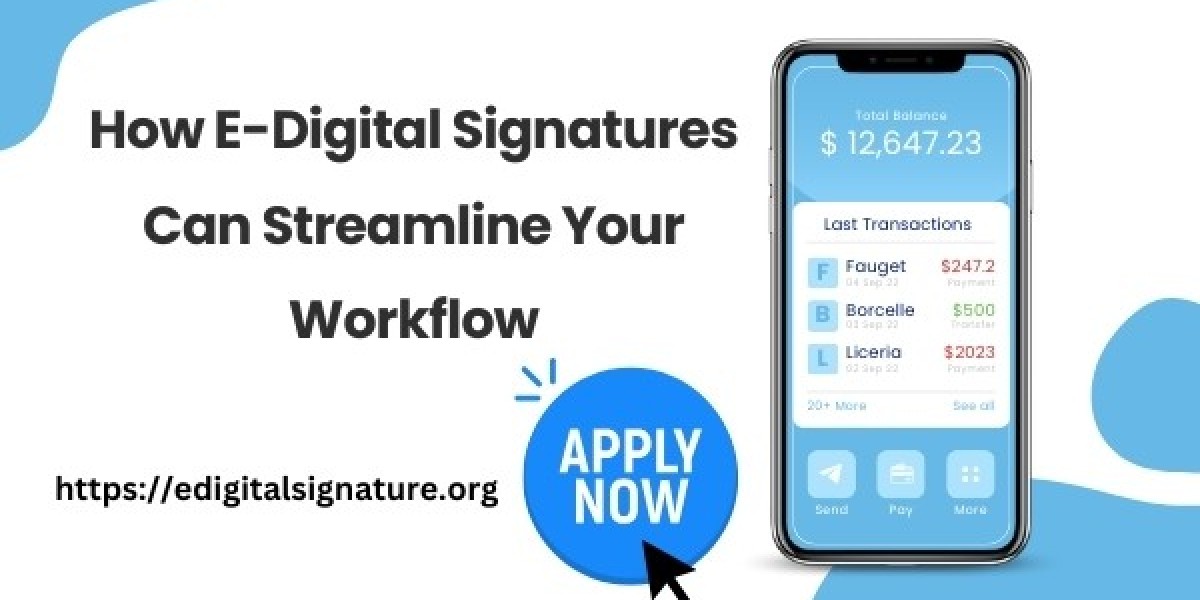In today's digital age, efficiency and speed are critical for business success. One technology that significantly enhances these aspects is the e-digital signature. E-digital signatures are transforming how businesses handle documents, contracts, and approvals, making workflows more streamlined and efficient. This article will explore how e-digital signatures can optimize your workflow and provide a smoother, faster, and more secure way to manage your documents.
What Are E-Digital Signatures?
Digital signature certificates, also known as electronic signatures, are a digital version of a handwritten signature. They use cryptographic technology to ensure the integrity and authenticity of electronic documents. Unlike traditional signatures, which require physical paperwork, e-digital signatures can be applied to digital documents, making the entire process faster and more convenient.
How E-Digital Signatures Work
E-digital signatures work by using encryption algorithms to secure the signing process. When you sign a document electronically, the signature is encrypted and linked to the specific document. This means that any alteration of the document after signing will be detectable, ensuring that the document remains unchanged and secure.
Here’s a simplified process of how e-digital signatures work:
- Document Preparation: The document that needs to be signed is prepared and uploaded to a digital signature platform.
- Signature Application: The signer applies their e-digital signature using a secure method, often involving a combination of personal identification and encryption.
- Verification: Once signed, the document is encrypted and linked to the signer’s identity. Verification processes ensure that the document has not been altered and confirms the signer's identity.
- Completion: The signed document is then finalized and can be stored or shared electronically.
Benefits of E-Digital Signatures
1. Speed and Efficiency
One of the most significant advantages of e-digital signatures is the speed at which they can streamline workflows. Traditional paper-based processes often involve printing, signing, scanning, and emailing documents. E-digital signatures eliminate these steps by allowing documents to be signed and processed entirely online. This reduces turnaround time, speeds up approvals, and enhances overall productivity.
2. Cost Savings
E-digital signatures can lead to substantial cost savings. By moving away from paper-based processes, businesses can reduce expenses related to printing, postage, and storage. Additionally, fewer errors and less time spent on document management can translate to lower operational costs.
3. Enhanced Security
Security is a major concern with document management, especially when handling sensitive information. E-digital signatures provide a higher level of security compared to traditional signatures. They use encryption and digital certificates to ensure that the document is authentic and has not been tampered with. This added layer of security helps protect against fraud and unauthorized access.
4. Improved Compliance
E-digital signatures help businesses comply with legal and regulatory requirements. Many countries have laws that recognize the validity of e-digital signatures, making them legally binding. By using e-digital signatures, businesses can ensure they are meeting compliance standards and maintaining the integrity of their documents.
5. Accessibility and Convenience
E-digital signatures offer convenience and accessibility, especially for businesses with remote or distributed teams. Signers can access documents and apply their signatures from anywhere in the world using a computer or mobile device. This flexibility facilitates faster decision-making and reduces the need for physical presence, which is especially beneficial for international transactions.
6. Reduced Environmental Impact
By transitioning to e-digital signatures, businesses can significantly reduce their environmental footprint. Digital documents eliminate the need for paper, ink, and physical storage, contributing to a more sustainable and eco-friendly operation. This shift not only benefits the environment but also aligns with modern corporate social responsibility goals.
7. Enhanced Document Management
E-digital signatures integrate seamlessly with digital document management systems. This integration allows for better organization, tracking, and retrieval of signed documents. Automated workflows can be set up to manage document routing, approval processes, and record-keeping, further streamlining operations and reducing manual effort.
Implementing E-Digital Signatures in Your Workflow
To effectively integrate e-digital signatures into your workflow, follow these steps:
1. Choose the Right Platform
Select a reliable e-digital signature platform that meets your business needs. Look for features such as ease of use, security protocols, integration capabilities, and customer support. Popular platforms include DocuSign, Adobe Sign, and HelloSign.
2. Train Your Team
Ensure that your team is familiar with the e-digital signature platform and understands its functionalities. Provide training and resources to help employees adapt to the new process and maximize its benefits.
3. Update Your Processes
Review and update your document management processes to incorporate e-digital signatures. Define clear procedures for document preparation, signing, and storage. Ensure that all relevant stakeholders are aware of the new workflow and how to use it effectively.
4. Monitor and Optimize
Continuously monitor the effectiveness of e-digital signatures in your workflow. Gather feedback from users, track performance metrics, and make adjustments as needed to optimize the process. Regularly review and update your digital signature practices to stay aligned with evolving technology and regulatory requirements.
Suggested Read - Class 3 Digital Signature Certificate For eTender
Conclusion
E-digital signatures offer numerous advantages for streamlining workflows and improving efficiency. By reducing the time and costs associated with traditional paper-based processes, enhancing security, and providing greater accessibility, e-digital signatures can transform how your business handles documents. As technology continues to advance, adopting e-digital signatures will not only keep your workflow modern and efficient but also contribute to a more sustainable and secure business environment. Embrace the power of e-digital signatures and unlock new levels of productivity and convenience in your operations.



